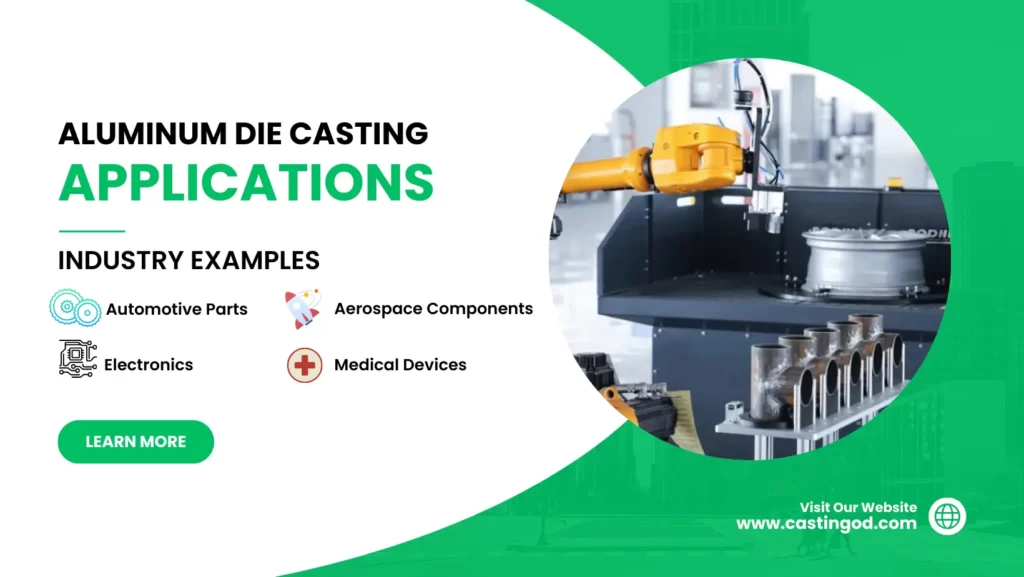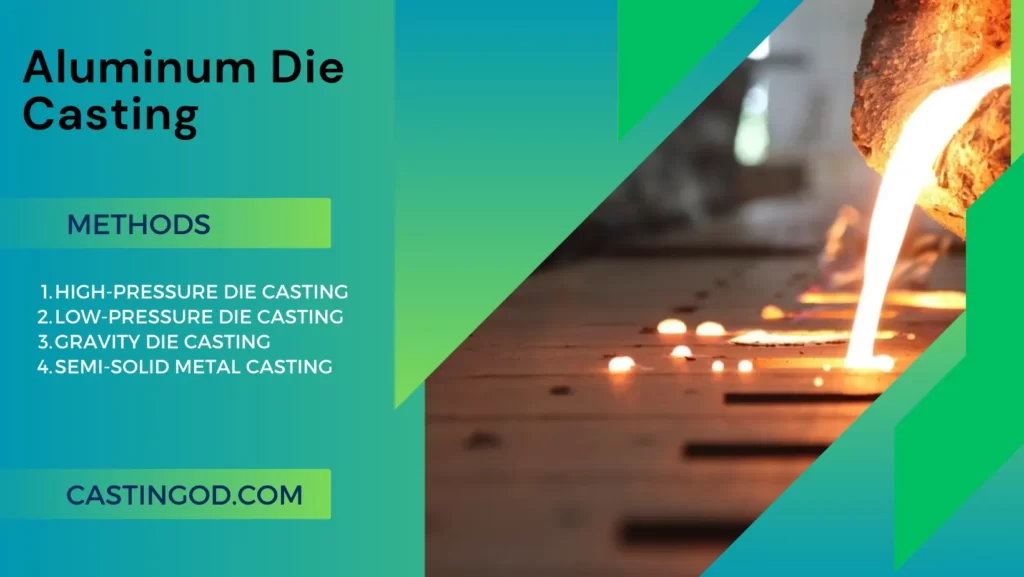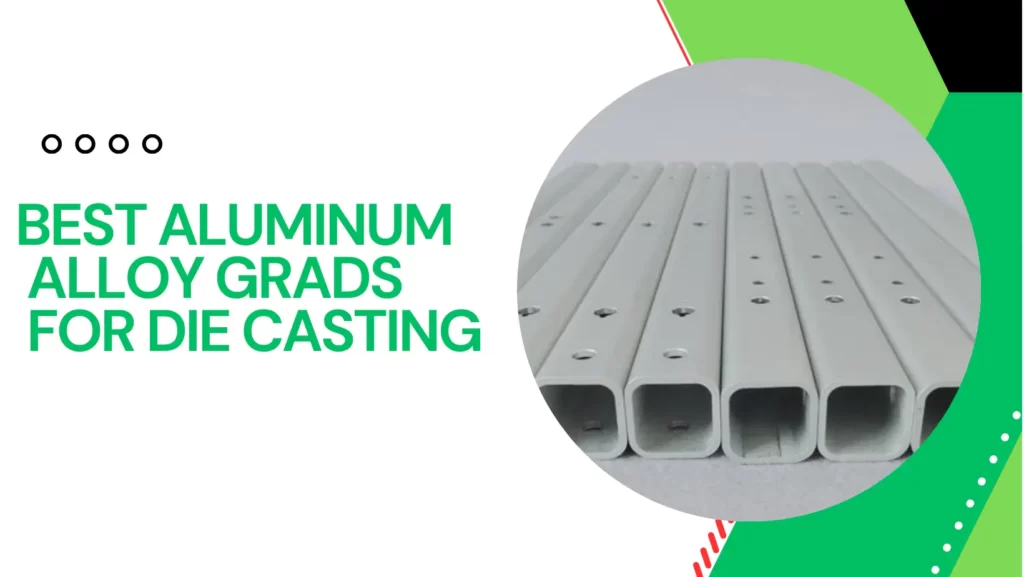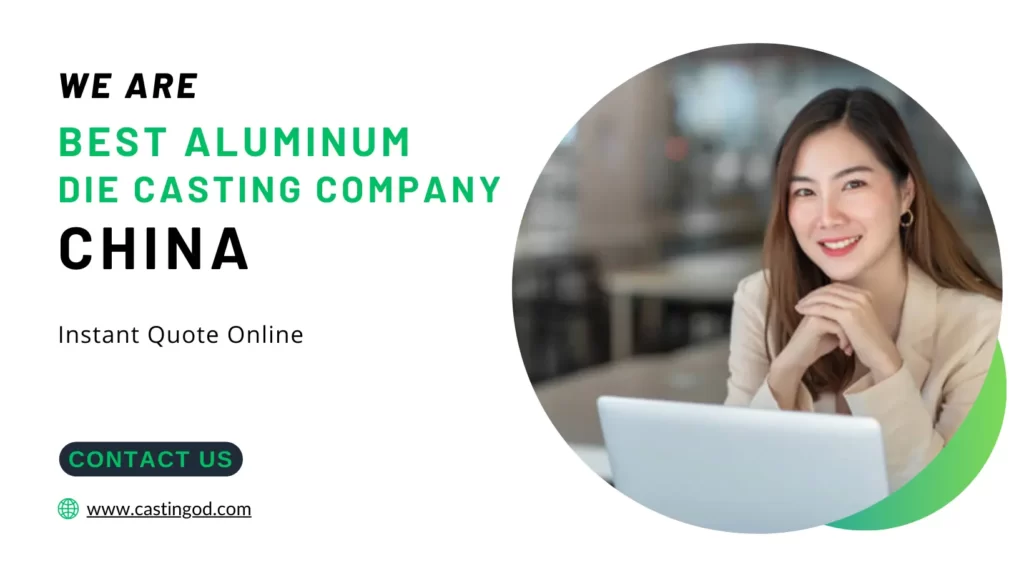There are many reasons why aluminum die casting is currently the most popular method for high volume manufacturing. The die-cast aluminum parts offer excellent stiffness, strength-to-weight ratio, high conductivity, and durability against corrosion.
The aluminum die casting method depends on rapid manufacturing. Compared to other casting methods, it has the potential to manufacture huge volume of die casting parts more quickly and effectively. Aluminum die casting is growing as a popular option across many worldwide companies, including:
- Automotive
- Aerospace
- Food and beverage
- Consumer Electronics
- Healthcare
- Clothing and Apparel Industry
- Consumer Goods
Applications of Aluminum Die Casting

Automotive Parts
Aluminum die casting is commonly used in the automotive industry. Aluminum alloys are flexible, durable, and corrosion-resistant, making them ideal for:
- Engine blocks
- Gearbox housings
- Steering knuckles
- Wheels
- Brake calipers
Example: Aluminum Alloy Transmission Housing Set Gearbox Cover
Price: $19.99
Aerospace Components
Example: You can find Aluminum Landing Gear Arms Draco
Price: $21.99
Consumer Electronics
The consumer electronics sector requires accuracy and excellent parts for its products, and aluminum die casting provides an affordable option for the manufacturing of complex and thin-walled parts. Aluminum die cast parts can be used in a wide range of electronic items, such as:
- Cellphones
- Laptop computers
- Cameras
- Audio equipment
- Housings
- Brackets
- Frames
- Heatsinks
Example: You can find Aluminum Heat Sink
Price: $14.99
Medical Devices
Aluminum die casting is commonly used in the medical equipment industry. The method is used to make a number of medical device parts, such as:
- Housings
- Implants
- Imaging equipment
- Surgical instruments
- Monitoring devices for patients
Example: You can find Aluminum Sensory Tuning
Price: $21.95
Construction Materials
The construction industry prefers aluminum die castings because of their robustness. Compared to other traditional options like heavy-weight steel, aluminum die casting provides solid yet lightweight parts that are simpler and quicker to use in a wide range of applications, including:
- Brackets
- Connectors
- Fixtures
Example: You can find an Aluminum Cylinder Wall Bracket
Price: $69.81
Lighting Fixtures
Aluminum die casting is also widely used in the lighting industry. The process is used to make a wide range of lighting components, such as:
- Housings
- Reflectors
- Diffusers
Example: You can find Diffuser Aluminum Floor.
Price: $1,270.00
Processes in Aluminum Die Casting

Die casting aluminum is a process of manufacturing metal parts. The right metal parts are produced by forcing an aluminum bar into the cavity of a pre-shaped mold after it is heated to a high temperature and fully melted.
Furthermore, the following are different types of die casting processes:
High-Pressure Die Casting
The process of high-pressure die casting requires the use of a high-pressure injection method to fill the molds with molten aluminum. Aluminum molten is poured into the mold during this process, producing components with high mechanical qualities, great finishing, and excellent similarity.
| Pros | Cons |
| Short casting cycles | High operating and investment costs |
| Suitable for thin-walled components | Complex, costly dies |
| Smooth surfaces | Sand cores cannot be used for die-cast parts |
| Well suited to automation | Lower strength values |
Low-Pressure Die Casting
Low-pressure die casting is a method for manufacturing aluminum parts, typically in a state of rotatory movement. Aluminum molten is added to the dies in this process by the furnace. This process works well for producing aluminum parts, such as automobile wheels.
| Pros | Cons |
| Excellent strength values | Slower casting cycles |
| Sand cores can be used to create complex geometries | Minimum wall thickness approx. 3 mm |
| Improved material efficiency and reduced feeder requirements | |
| Superior dimensional accuracy | |
| Every step is well-suited to automation | |
| Simpler die and machine technology |
Gravity Die Casting
Gravity die casting uses either permanent or semi-permanent dies. Once the aluminum melts in the ladle, it goes in straight from there after being heated. Gravity die casting is a particular technique that can be used to produce such extremely heavy and premium quality aluminum parts.
| Pros | Cons |
| Excellent surface finish | High mold cost |
| Tight dimensional tolerance | Unsuitable for casting high-melt metals |
| Take small floor space | |
| Thin castings can be produced easily | |
| Perfect for large-scale manufacturing | |
| Reduces skill requirements |
Semi-Solid Metal Casting
Semi-solid casting material is used in the semi-solid die casting method Instead of entirely molten metal, which is 50% solid and 50% liquid. The melting point of the metal is such that the slurry keeps its semi-aggressive state. The metal keeps its 30%–60% solid state at the ideal temperature of up to 10 degrees Celsius.
The viscosity of metal slurry can be raised by 40% by adding more solid material, which affects the semi-solid die casting procedure. When the metal is cooled, any dendrites that may have been produced are broken down, making the metal more ductile. Depending on the alloy used, the right semi-solid technique is then used for die casting.
| Pros | Cons |
| Intricate parts made in nearly net forms | Temperature control is a major drawback |
| Outstanding mechanical performance | procedure’s equipment is more expensive |
| Casting thin walls is possible | |
| Heat treatment can be applied | |
| No air entrapment during casting | |
| Low shrinkage during solidification | |
| The entire cast’s microstructure is uniform |
Which Aluminum Alloy Grades Are Best for Die Casting?

A380 Aluminum Alloy
This is the most common and well-liked aluminum alloy for die casting. Die casting requires high mechanical and physical properties, which is why it is recommended.
These features include corrosion resistance, being lightweight, and the ability to operate at extremely high temperatures.
The A380 aluminum alloy offers dimensional stability even with its complex shapes and thin walls.
Advantages of Die Cast A380 Aluminum Alloy
- Die casting offers variety in surface finishing options for lighter parts.
- It has the highest operating temperatures of any aluminum die cast alloy.
- It doesn’t corrode easily.
- Its application can be in various industries due to its high dimensional stability and retention.
Applications of Die Cast A380 Aluminum Alloy
- Hand tools,
- Electronic equipment
- Chassis
- Engine brackets
- Power tools
- Household furniture
A360 Aluminum Alloy
This aluminum alloy is more difficult to die cast than A380. The A360 aluminum alloy offers outstanding durability at high temperatures, depending on casting capabilities and needs.
Advantages of Die Cast A360 Aluminum Alloy
- It is highly corrosion resistant.
- It has greater strength at higher temperatures.
- Increased flexibility
- Challenging to cast
Applications of A360 Aluminum Alloy
- Vehicle oil pans
- Motor vehicle controller shells
- Motor shells
- 5G communication boxes
- LED lamp housing
A356 Aluminum Alloy
Aluminum A356 alloy is a popular material in die casting. It is available in three brands:
- A356.0
- A356.1
- A356.2
Advantages of Die Cast A356 Aluminum Alloy
- It can be cast easily.
- It is lightweight.
- It has outstanding mechanical characteristics.
- It offers outstanding qualities for weldability.
- It has excellent resistance against corrosion
- No hot cracking tendency
- The linear shrinkage is low.
Applications of Die Cast A356 Aluminum Alloy
- Impellers and blowers
- Space and airframe structures
- Truck chassis parts
- High strength machine parts
- Pump bodies
- Automotive transmission cases
- Oil pans
What Makes Steel Perfect for Creating Aluminum Die Casting Molds?
Nowadays, H13, H11, the new steel Y10, and HM3 are the most popular aluminum alloy die casting mold steels. 3Cr2W8V has the best tempering resistance, thermal stability, and very high heat resistance.
On the other hand, steel has a high thermal expansion coefficient and low heat conductivity as a result of its high tungsten concentration. As a result, the die cavity’s surface is subject to cold and hot fatigue cracks, and its resistance to these conditions is low.
H13 steel has much greater longevity than 3Cr2W8V steel for aluminum alloy die casting dies.
The following are the basic steel performance standards for molds:
- Strong durability to tempering and fatigue in both cold and hot conditions.
- Good hardness, flexibility, heat resistance, and strength
- Excellent heat transfer capacity.
- Excellent molten metal resistance.
- Low heat treatment deformation and excellent hardness
Use of a Lubricant and Release Agent in Die Casting
During the die-casting process, auxiliary materials like punch lubricant and mold release agent are needed to ensure that the die casting is smooth and has a complete shape. These extend the life of the mold cavity and punch and make the die casting smooth.
The function of a die casting release agent is as follows:
- offers good lubricating qualities when heated;
- The mold will experience a cooling effect. Different mold parts’ temperatures can be adjusted for relative stability, which will enhance casting quality and production effectiveness.
- Enhance the mold’s working conditions to prevent metal liquid from affecting it:
- Keep the mold from sticking.
- Lessen the friction between the casting and the mold’s forming part
Surface Finish Guidelines for Die Cast Aluminum Alloy
Chrome Plating
This is a costly surface finishing technique. The technique provides a mirror-like finish on the die cast aluminum alloy.
In the automotive sector, bright chrome is widely used. Satin chrome is used as well because it has a pearly effect.
Anodizing
Anodizing involves an electrochemical method. It turns the surface of the die-cast aluminum alloy into an attractive, long-lasting, corrosion-resistant finish.
This oxide is applied fully within the die cast aluminum alloy, unlike paint or plating on the outside.
Powder Coating
This dry coating process primarily works on die cast aluminum alloys, which are used to make machinery for commercial use.
A powder coating can be created on the surface by applying dry powder through an electrostatic process. It is also durable against dents and scratches.
Shiny Nickel
This is a finishing technique that coats the die-cast aluminum alloy’s surface with a layer of shining nickel over a layer of semi-bright nickel.
It is not recommended that you apply this finish to parts that might be bent or twisted shortly after plating due to their ability to be brittle.
Polishing
This is a finishing method where abrasive material is used to polish the die cast aluminum alloy’s surface.
Generally, the objectives are to improve the die cast aluminum alloy’s appearance, minimize damage, and boost reflectivity.
It serves as a protective coating for die-cast aluminum alloys, improving their longevity. Additionally, it reduces corrosion and degradation of the die-cast aluminum alloy.
Painting
Paint can be used to give the die cast aluminum alloy a natural finish.
The die cast aluminum alloy can be painted by one’s brand and will look great when used on a pre-treated surface.









